Numerical Investigation of the Use of Electrically Conductive Concrete-Encased Electrodes as Potential Replacement for Substation Grounding Systems
Abstract
:1. Introduction
2. Validation of Conventional SGS Modeling Using General FEM Software
2.1. Geometry and Parameters of an SGS
2.2. Construction of the FEM Model of the Grounding Grid
2.3. Validation of the Proposed FEM Model
3. Numerical Investigation of the ECON-EE Grounding
3.1. ECON-EE Grounding Modeling
3.2. Influence of the ECON-EE Square Section Area
3.3. Influence of the Electrical Conductivity of the ECON-EE Square Section
3.4. Influence of the Geometry of the ECON-EE Section
3.4.1. Circular and Rectangular Sections of the Same Area
3.4.2. Circular and Rectangular Sections with the Same Perimeter
3.5. Influence of the Rebar Diameter
4. Discussion
4.1. Most Influential ECON-EE Parameters
4.1.1. ECON-EE Section Area
4.1.2. ECON-EE Resistivity
4.2. Efficiency of the ECON-EE Grounding System Compared to Copper Grid
4.3. Advantages and Disadvantages of Using an ECON-EE Grounding System for a Substation
4.3.1. Advantages of the ECON-EE Grounding System
4.3.2. Disadvantages of the ECON-EE Grounding System
5. Conclusions
Author Contributions
Funding
Data Availability Statement
Conflicts of Interest
References
- Hyung-Soo, L.; Jung-Hoon, K.; Dawalibi, F.P.; Jinxi, M. Efficient ground grids designs in layered solids. IEEE Trans. Power Deliv. 1998, 13, 745–751. [Google Scholar] [CrossRef]
- Permal, N.; Osman, M.; Ariffin, A.M.; Kadir, M.Z.A. The Impact of Substation Grounding Grid Design Parameters in Non-Homogenous Soil to the Grid Safety Threshold Parameters. IEEE Access 2021, 9, 37497–37509. [Google Scholar] [CrossRef]
- Abdul Ali, A.; Ahmad, N.; Mohamad Nor, N.; Reffin, M.; Syed Abdullah, S. Investigations on the performance of a new grounding device with spike rods under high magnitude current conditions. Energies 2020, 13, 3538. [Google Scholar] [CrossRef]
- IEEE Std 80-2013; IEEE Guide for Safety in AC Substation Grounding. IEEE: Piscataway, NJ, USA, 2013.
- Nikolovski, S.; Kneevic, G.; Baus, Z. Assessment of step and touch voltages for different multilayer soil models of complex grounding grid. Int. J. Electr. Comput. Eng. 2016, 6, 1441–1455. [Google Scholar]
- Lim, S.C.; Gomes, C.; Kadir, Z.M.A. Electrical earthing in troubled environment. Elec. Power Energy Syst. 2013, 47, 117–128. [Google Scholar] [CrossRef]
- Azmi, A.; Ahmad, N.A.; Yiew, L.K.; Abdul-Malek, Z. The use of enhancement material in grounding system: A review. Indones. J. Electr. Eng. Comput. Sci. 2019, 13, 453–460. [Google Scholar] [CrossRef]
- Farren, E.J.; Hallmark, C.L. Why a low resistance to remote Earth is desirable and how to obtain it. In Proceedings of the Twenty-Second International Telecommunications Energy Conference (INTELEC), Phoenix, AZ, USA, 10–14 September 2000. [Google Scholar]
- Schroeder, J. Practical Issues in Grounding: Bentonite vs. Conductive Concrete. In Proceedings of the Protection Enginners Group Conference, Monroe, MI, USA, 5–7 April 2016. [Google Scholar]
- Hallmark, C.L. The use of conductive cement to extend and protect made ground electrodes. In Proceedings of the AREMA Annual Conference, Dallas, DA, USA, 9–13 October 2000. [Google Scholar]
- Androvitsaneas, V.P.; Gonos, I.F.; Stathopulos, I.A. Experimental study on transient impedance of grounding rods encased in ground enhancing compounds. Electr. Power Syst. Res. 2016, 139, 109–115. [Google Scholar] [CrossRef]
- Ufer, H.G. Investigation and Testing of Footing-Type Grounding Electrodes for Electrical Installations. IEEE Trans. Power App. Syst. 1964, 83, 1042–1048. [Google Scholar] [CrossRef]
- Fagan, E.J.; Lee, R.H. The Use of Concrete-Enclosed Reinforcing Rods as Grounding Electrodes. IEEE Trans. Indus. Gen. Appl. 1970, 6, 337–348. [Google Scholar] [CrossRef]
- Cabral, R.J.; Gazzana, D.S.; Tronchoni, A.B.; Dias, G.A.; Leborgne, R.C.; Bretas, A.S.; Telló, M. Comparative performance of impulsive grounding systems embedded in concrete: An experiment in reduced scale. In Proceedings of the 33rd International Conference on Lightning Protection (ICLP), Estoril, Portugal, 25–30 September 2016. [Google Scholar]
- Earley, M.W.; Sargent, J.S.; Sheehan, J.V.; Buss, E.W. National Electrical Code Handbook, 11th ed.; NFPA: Quincy, MA, USA, 2008; p. 223. [Google Scholar]
- Xie, P.; Beaudoin, J.J. Electrically Conductive Concrete and Its Application in Deicing: Advances in Concrete Technology. In Proceeding of the 2nd CANMET/ACI International Symposium, Las Vegas, NV, USA, 11–14 June 1995. [Google Scholar]
- Chung, D.D.L. Electrically conductive cement-based materials. Adv. Cem. Res. 2004, 16, 167–176. [Google Scholar] [CrossRef]
- Rahman, M.L.; Malakooti, A.; Ceylan, H.; Kim, S.; Taylor, P.C. A review of electrically conductive concrete heated pavement system technology: From the laboratory to the full-scale implementation. Constr. Build. Mater. 2022, 329, 127139. [Google Scholar] [CrossRef]
- Tuan, C.Y. Electrical Resistance Heating of Conductive Concrete Containing Steel Fibers and Shavings. ACI Mater. J. 2004, 101, 65–71. [Google Scholar]
- Sassani, A.; Ceylan, H.; Kim, S.; Arabzadeh, A.; Taylor, P.C.; Gopalakrishnan, K. Development of carbon fiber-modified electrically conductive concrete for implementation in Des Moines International Airport. Case Stud. Constr. Mater. 2018, 8, 277–291. [Google Scholar] [CrossRef]
- Lee, C.Y.; Wand, S.R. A study of grounding grid characteristics with conductive concrete. Int. J. Electr. Comput. Eng. 2009, 3, 2229–2234. [Google Scholar]
- Zhang, J.; Xu, L.; Zhao, Q. Investigation of carbon fillers modified electrically conductive concrete as grounding electrodes for transmission towers: Computational model and case study. Constr. Build. Mater. 2017, 145, 347–353. [Google Scholar] [CrossRef]
- Tian, X.; Pei, F.; Liu, X.; Jia, L.; Deng, C.; Lan, F.; Cheng, H. Analysis of Electrothermal Characteristics of Conductive Concrete Foundation of Power Tower. In IOP Conference Series: Earth and Environmental Science; IOP Publishing: Bristol, UK, 2020; Volume 571, p. 012057. [Google Scholar]
- Trlep, M.; Anton, H.; Božidar, H. The analysis of complex grounding systems by FEM. IEEE Trans. Magn. 1998, 34, 2521–2524. [Google Scholar] [CrossRef]
- Güemes, J.A.; Hernando, F.E. Method for Calculating the Ground Resistance of Grounding Grids Using FEM. IEEE Trans. Power Deliv. 2004, 19, 595–600. [Google Scholar] [CrossRef]
- Brennas, M.; Foiadelli, F.; Longo, M.; Zaninelli, D. Particular grounding systems analysis using FEM models. In Proceedings of the 18th International Conference on Harmonics and Quality of Power (ICHQP), Ljubljana, Slovenia, 13–16 May 2018. [Google Scholar]
- Samadinasab, S.; Namdari, F.; Bakhshipour, M. A novel approach for earthing system design using finite element method. J. Intell. Proced. Electr. Technol. 2017, 8, 54–63. [Google Scholar]
- Elek.com. Available online: https://elek.com.au/articles/earthing-software-benchmark-study (accessed on 12 May 2022).
- COMSOL Multiphysics Reference Manual. Available online: https://doc.comsol.com/5.5/doc/com.comsol.help.comsol/COMSOL_ReferenceManual.pdf (accessed on 22 March 2022).
- Eddy, I.; Underhill, P.R.; Morelli, J.; Krause, T.W. Pulsed eddy current response to general corrosion in concrete rebar. In Proceedings of the 46th Annual Review of Progress in Quantitative Nondestructive Evaluation (QNDE), Portland, OR, USA, 14–19 July 2019. [Google Scholar]
- Galvan, A.; Pretelin, G.; Goana, E. Practical evaluation of ground enhancing compounds for high soil resistivities. In Proceedings of the 30th International Conference on Lightning Protection (ICLP), Cagliari, Italy, 13–17 September 2010. [Google Scholar]
- Kurtovic, M.; Vujevic, S. Earthing grid parameters with conductor surrounded by an additional substance. IEE Proc.-Gener. Transm. Distrib. 2000, 147, 57–61. [Google Scholar] [CrossRef]
- Zubic, S.; Gajic, Z.; Kralj, D. Line protection operate time: How fast shall it be? IEEE Access 2021, 9, 75608–75616. [Google Scholar] [CrossRef]
- HomeAdvisor. Available online: https://www.homeadvisor.com/cost/outdoor-living/steel-reinforcement-bars-pricing/ (accessed on 20 May 2023).
- Xu, T.; Feng, P.; Xin, L.; Lulu, J.; Chenxing, D.; Pinghao, Y.; Hongbo, C. Comparison of corrosion characteristics of conductive concrete. In IOP Conference Series: Earth and Environmental Science; IOP Publishing: Bristol, UK, 2020; Volume 431, p. 012048. [Google Scholar]
- Civil Engineering Talks. Available online: https://civilengineeringtalks.com/types-of-rebar/ (accessed on 20 May 2023).
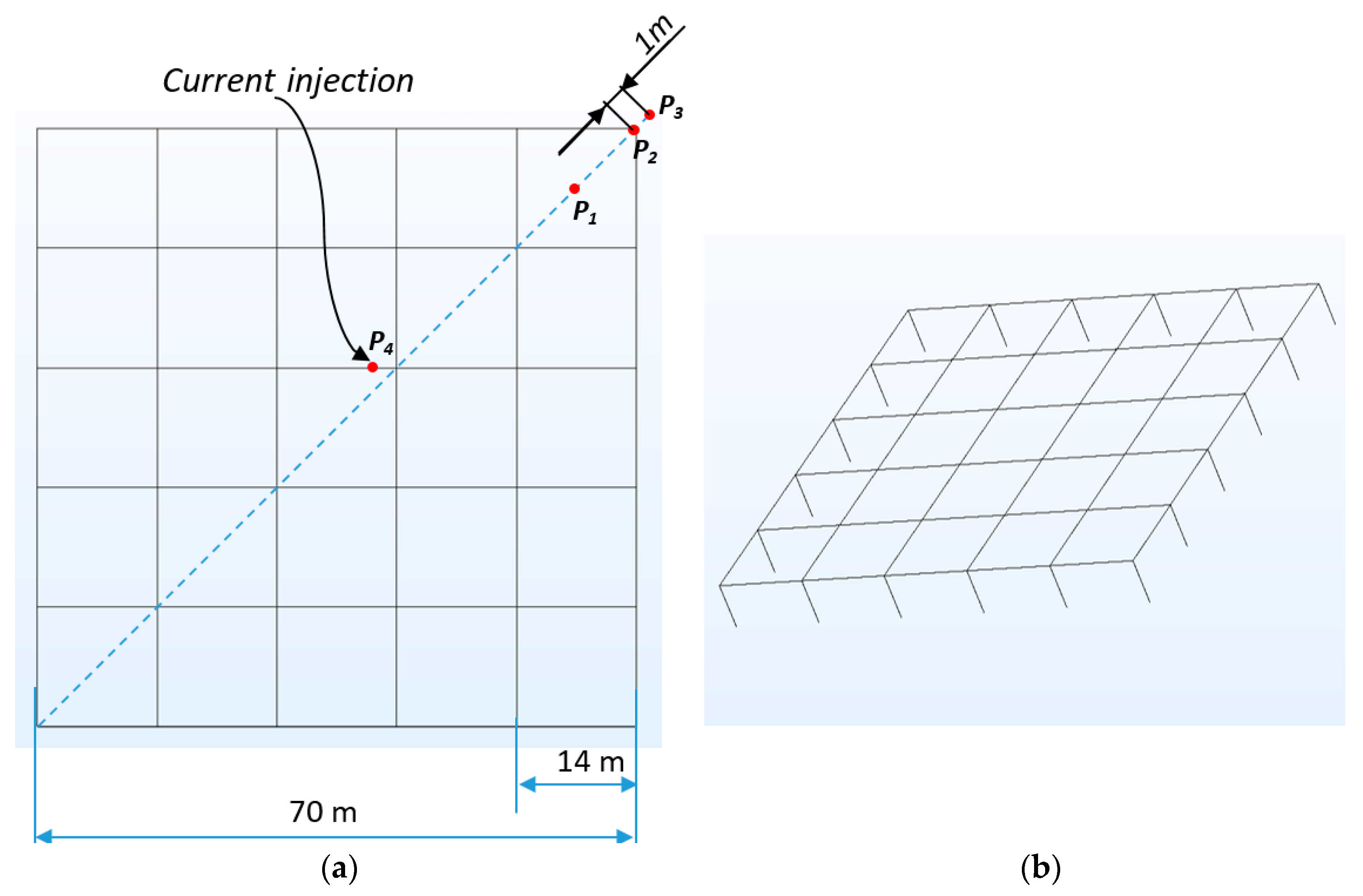

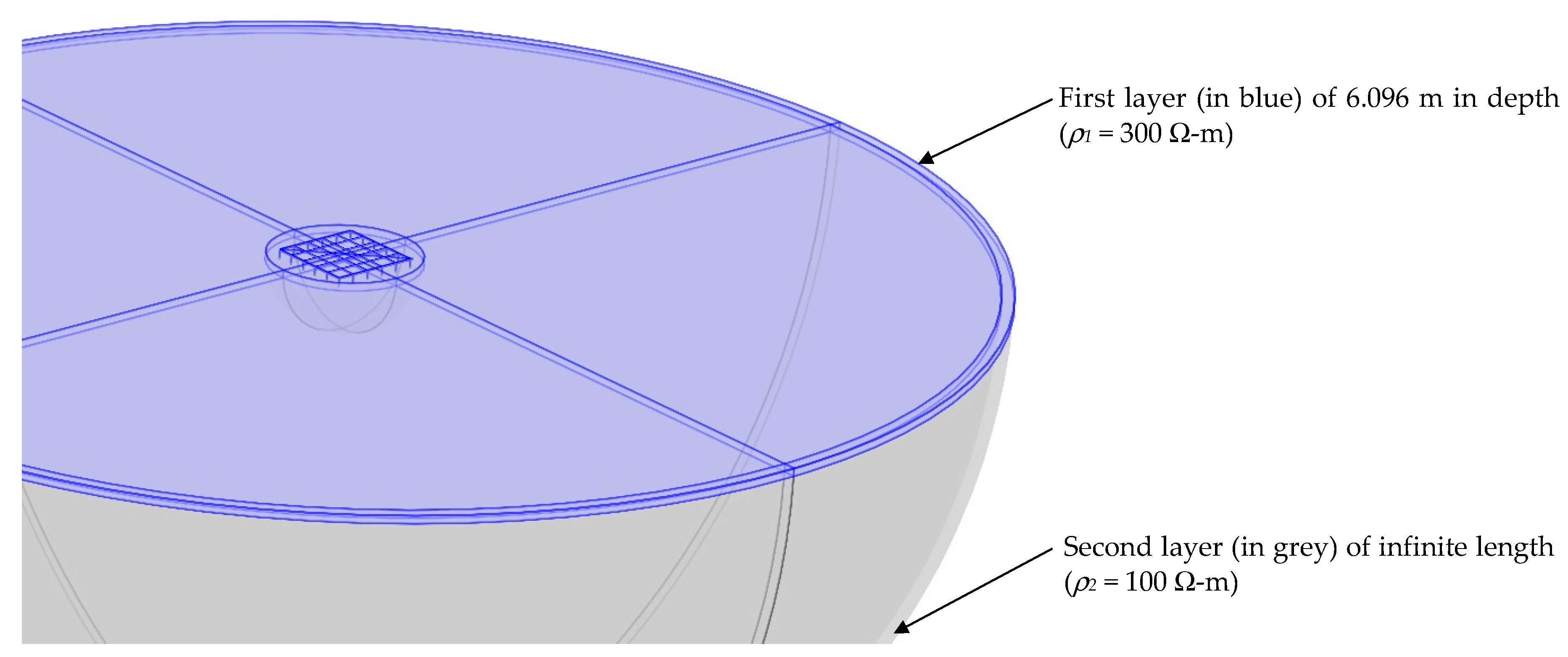
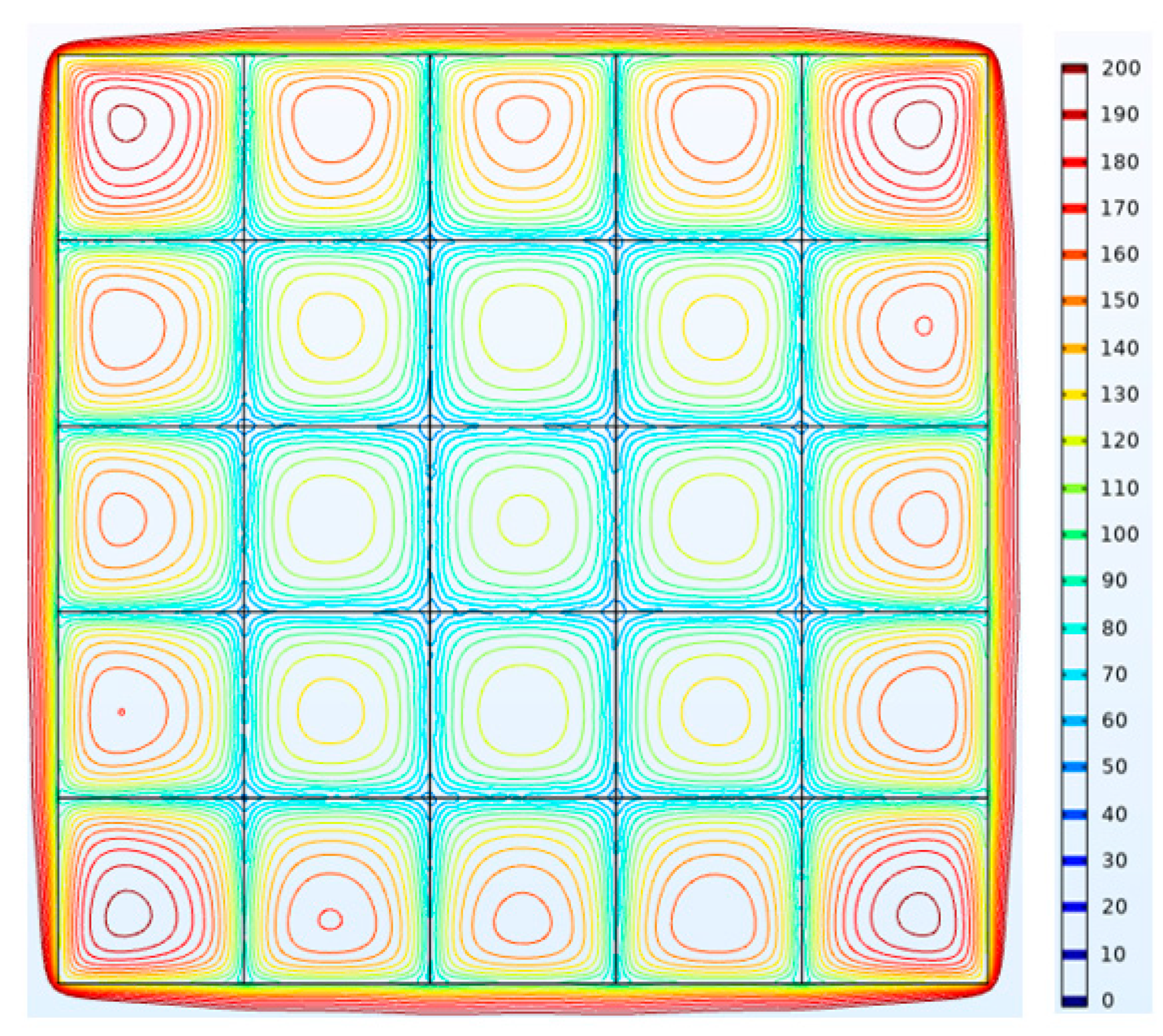
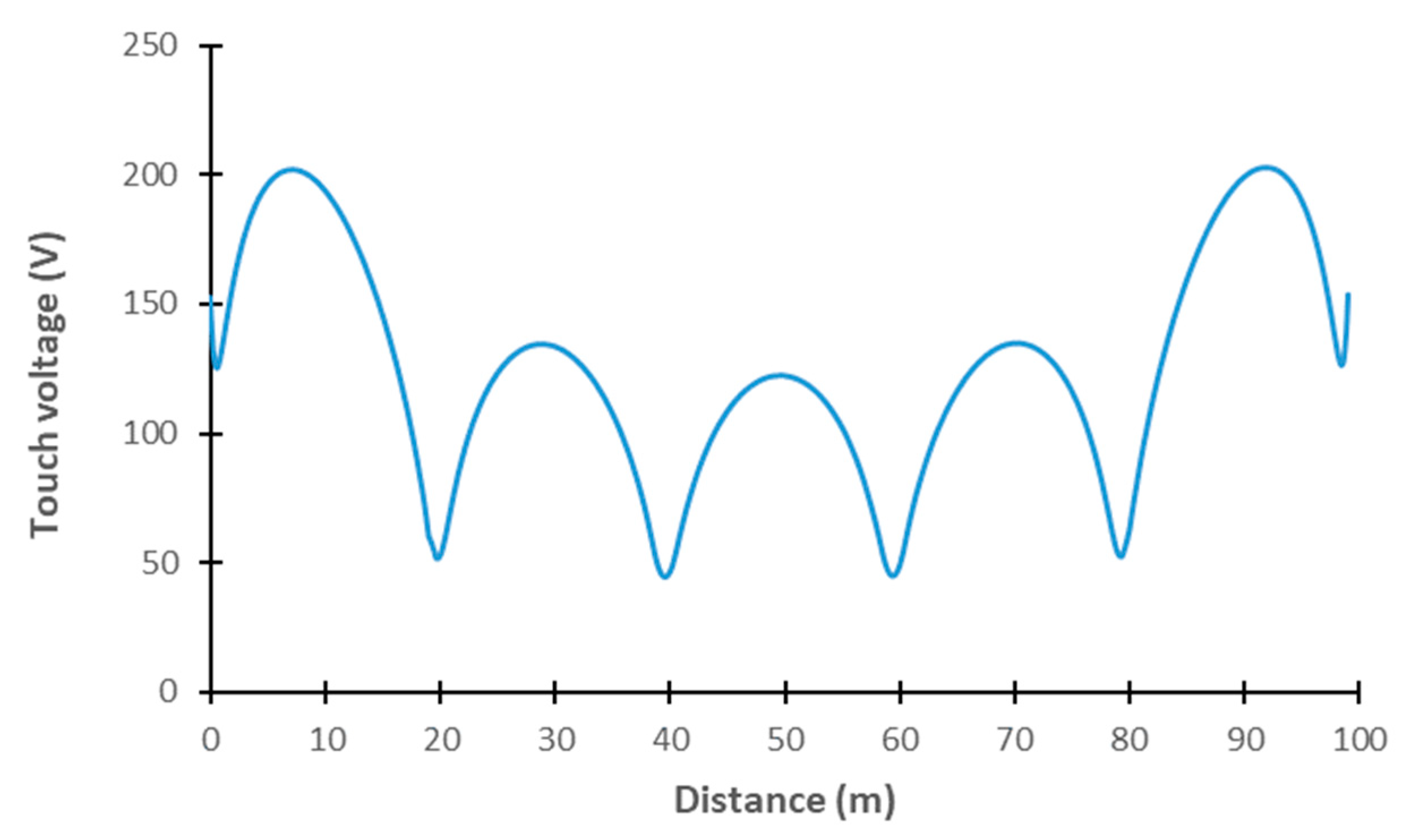
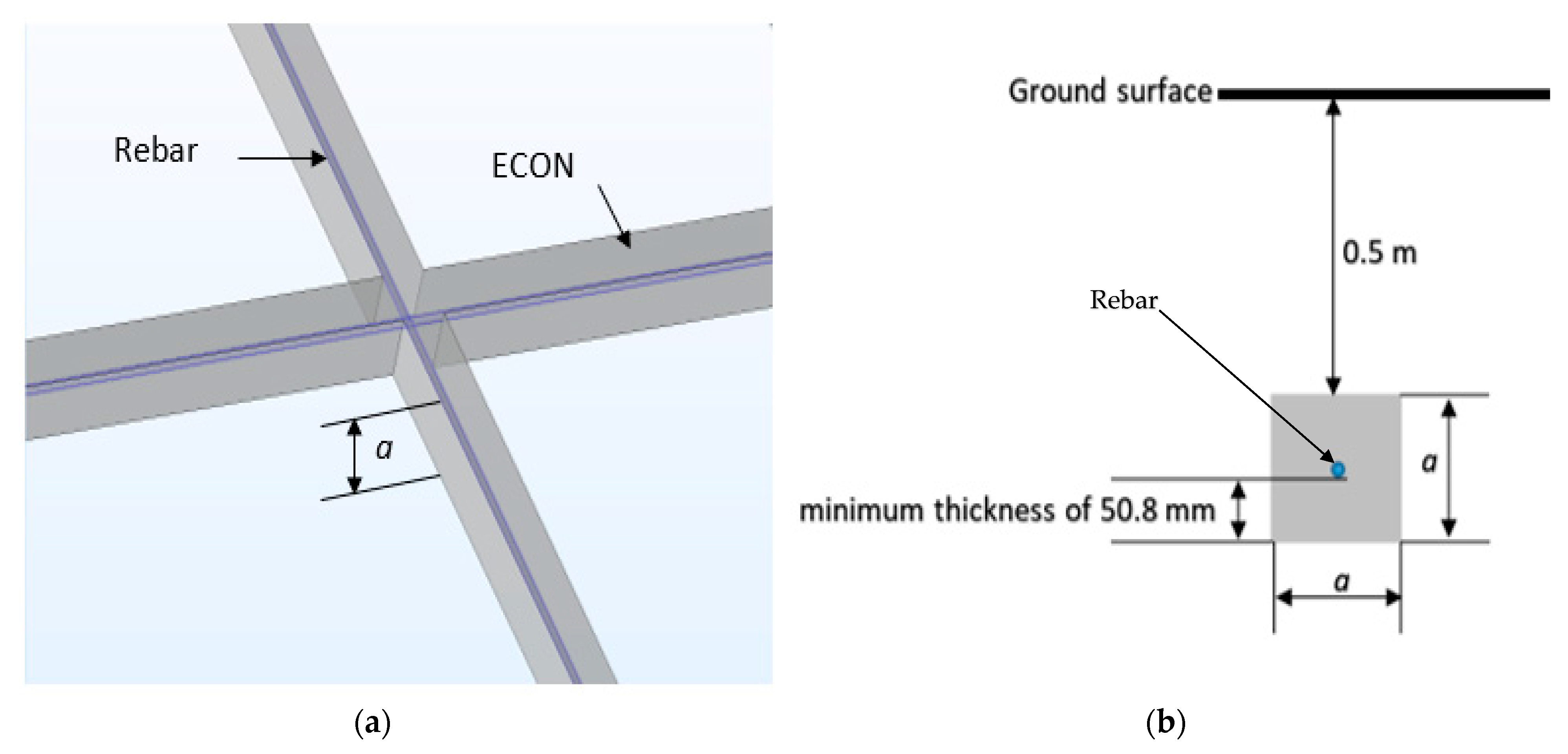
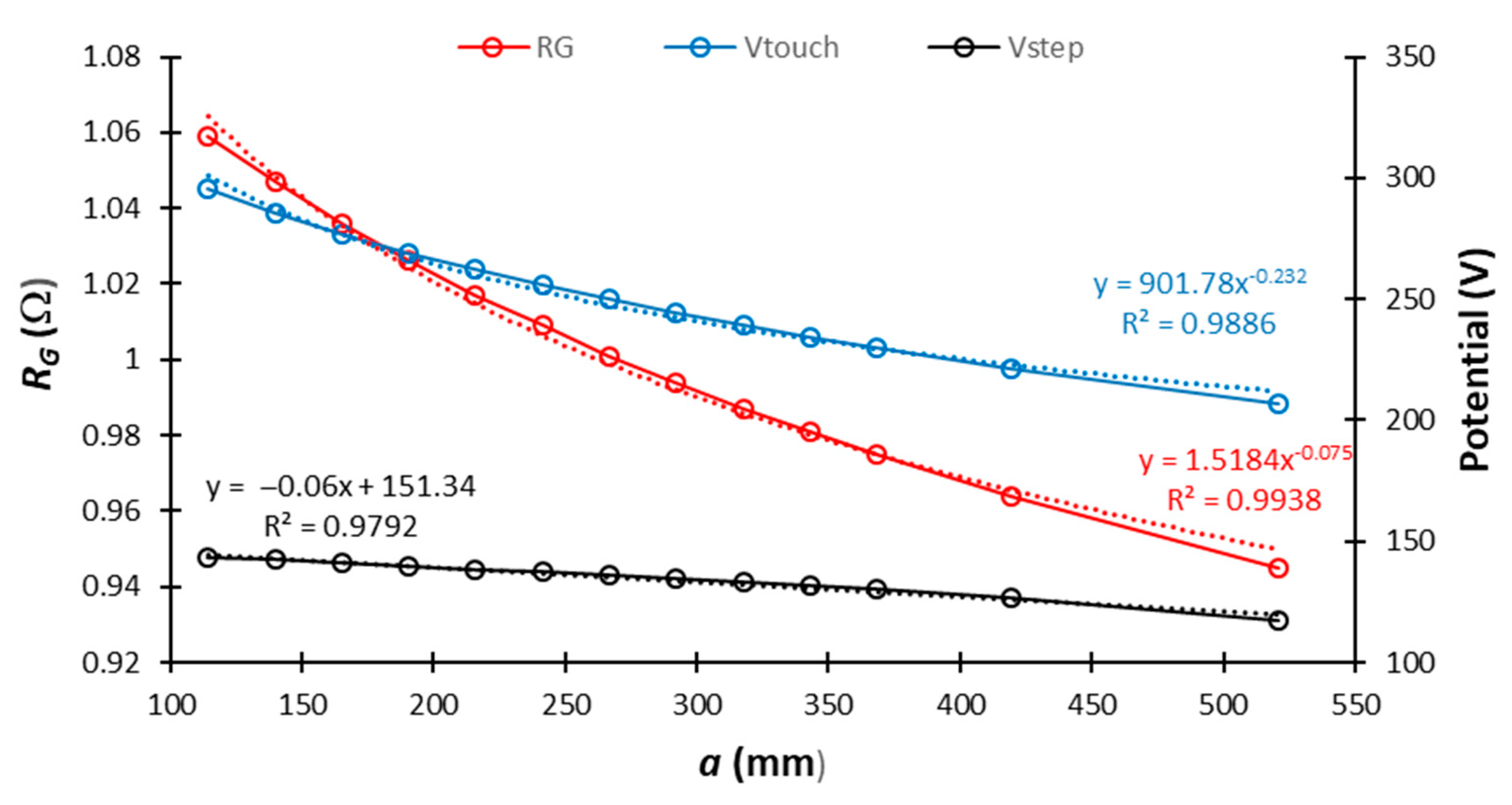
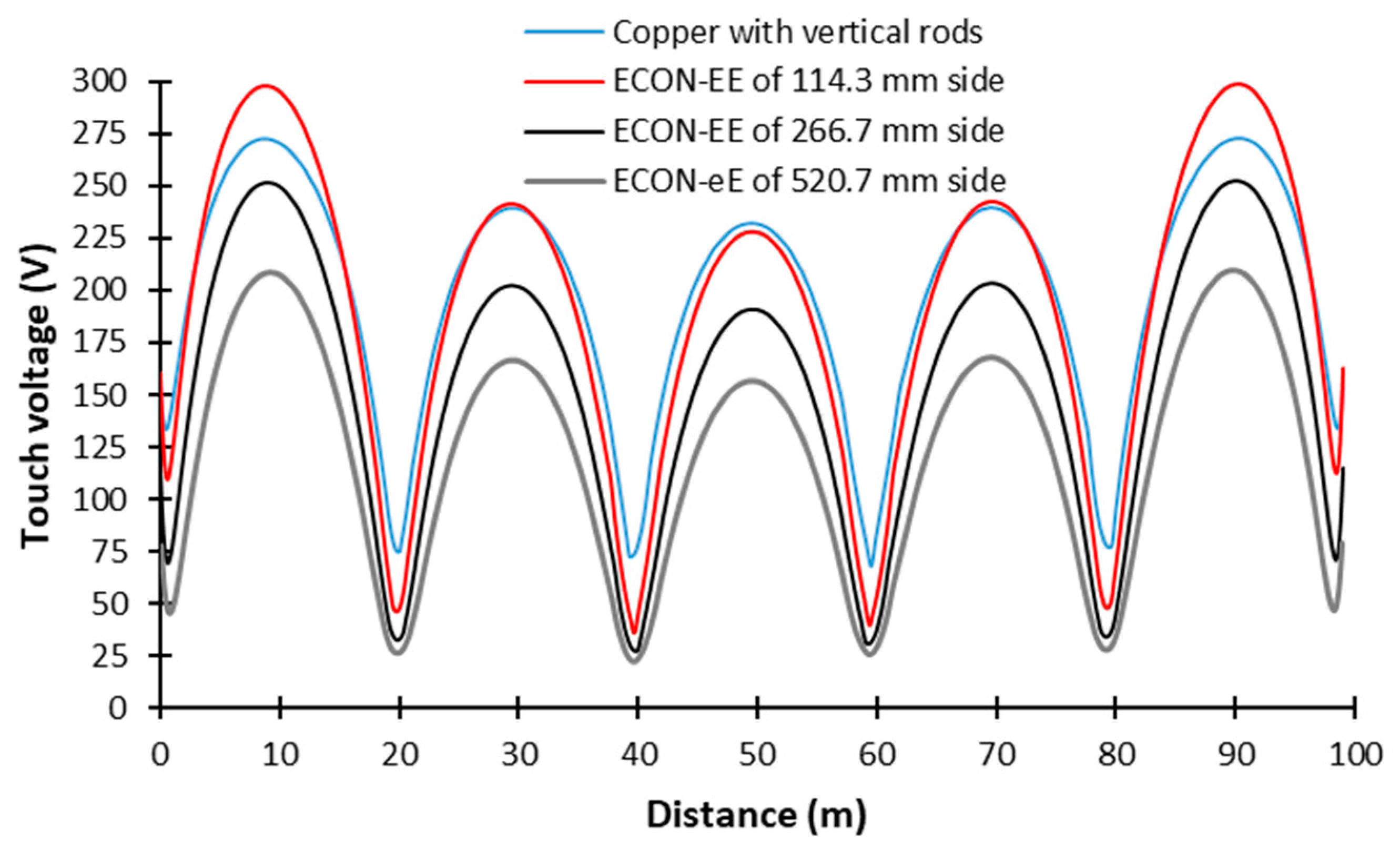
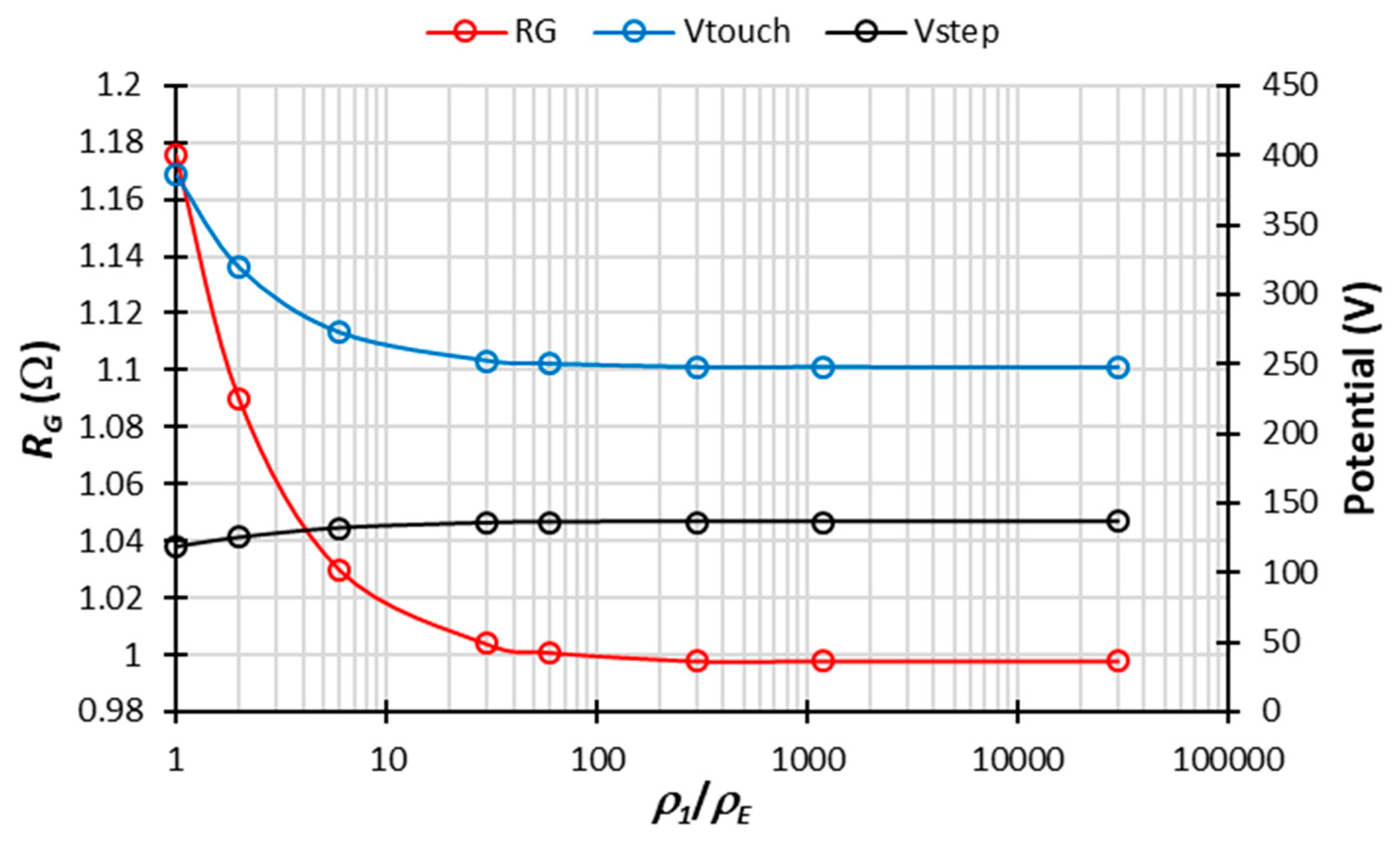
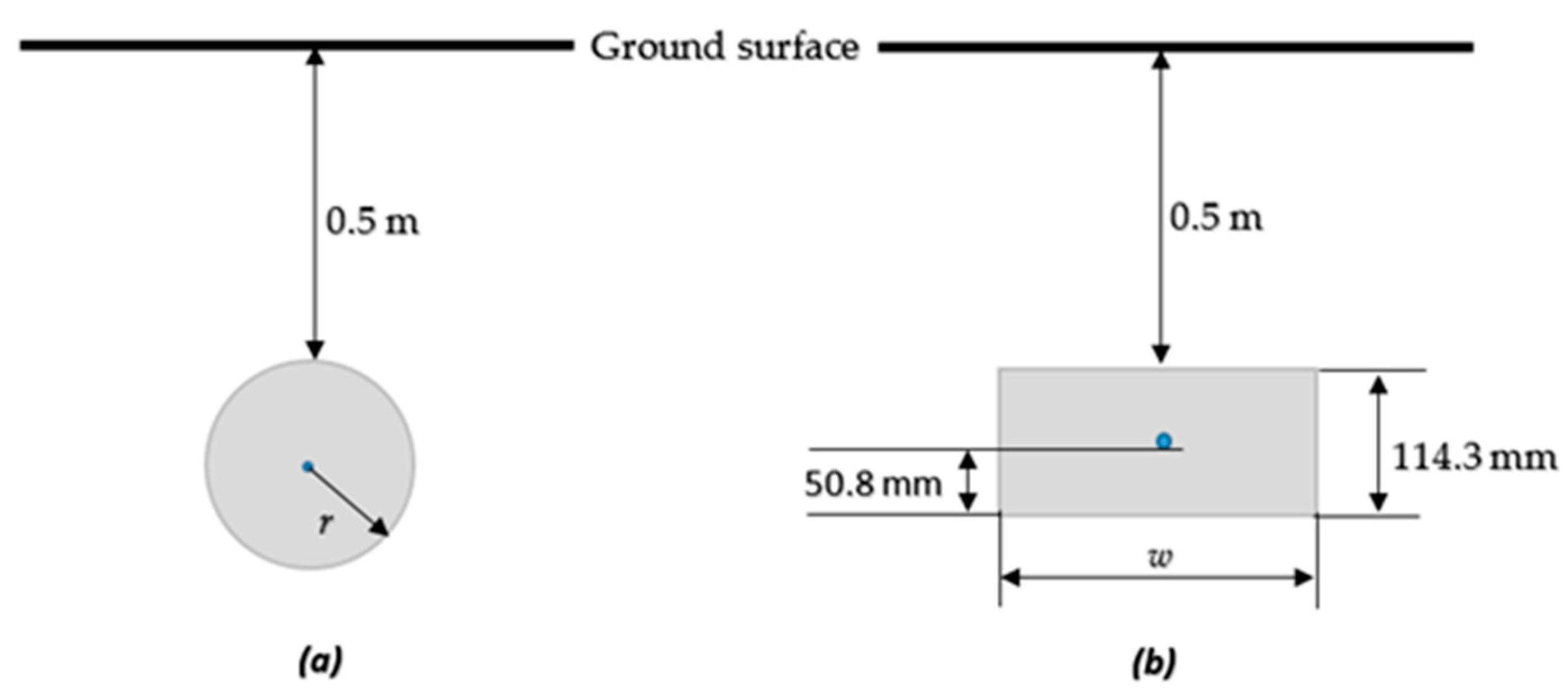
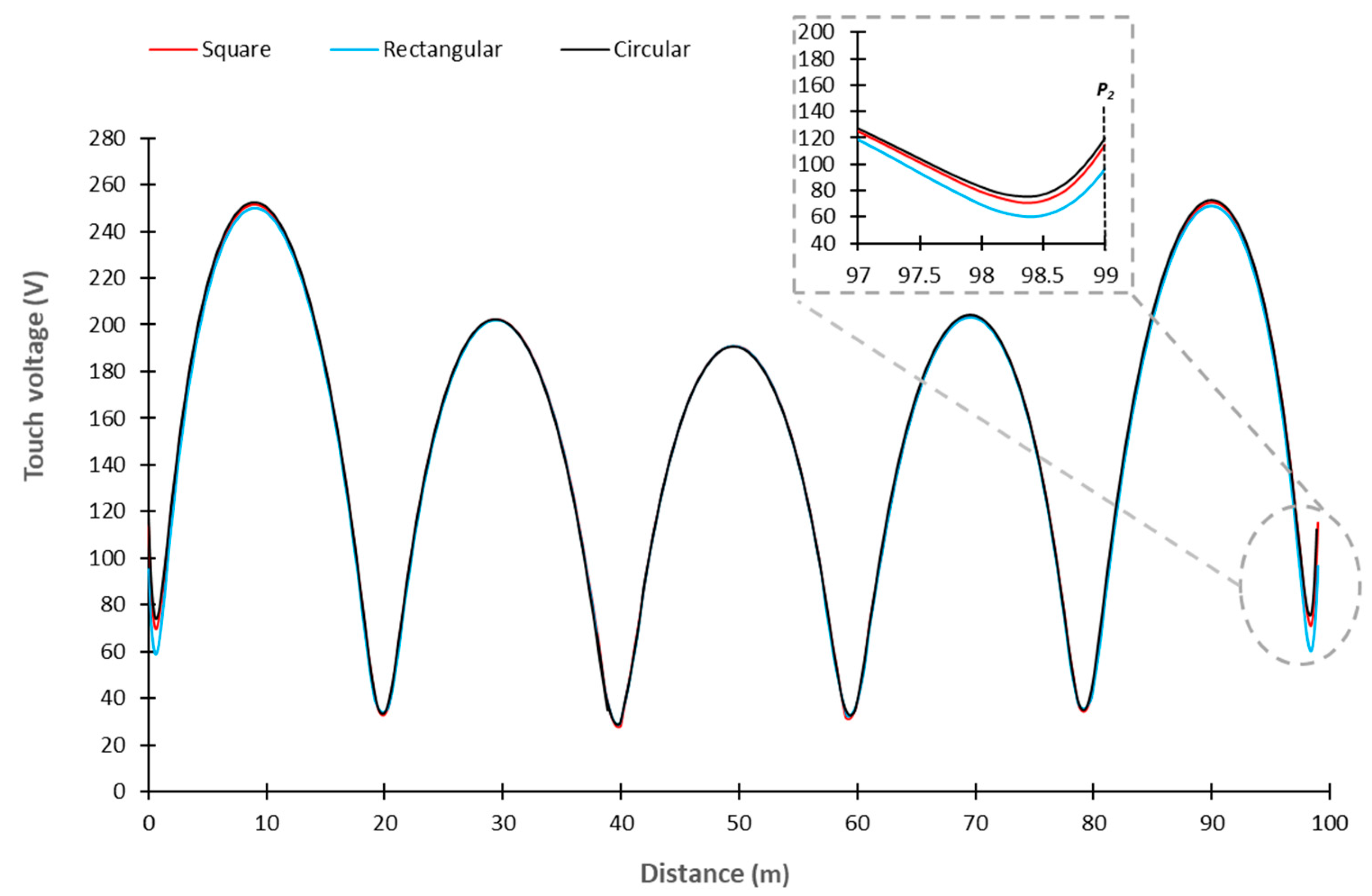
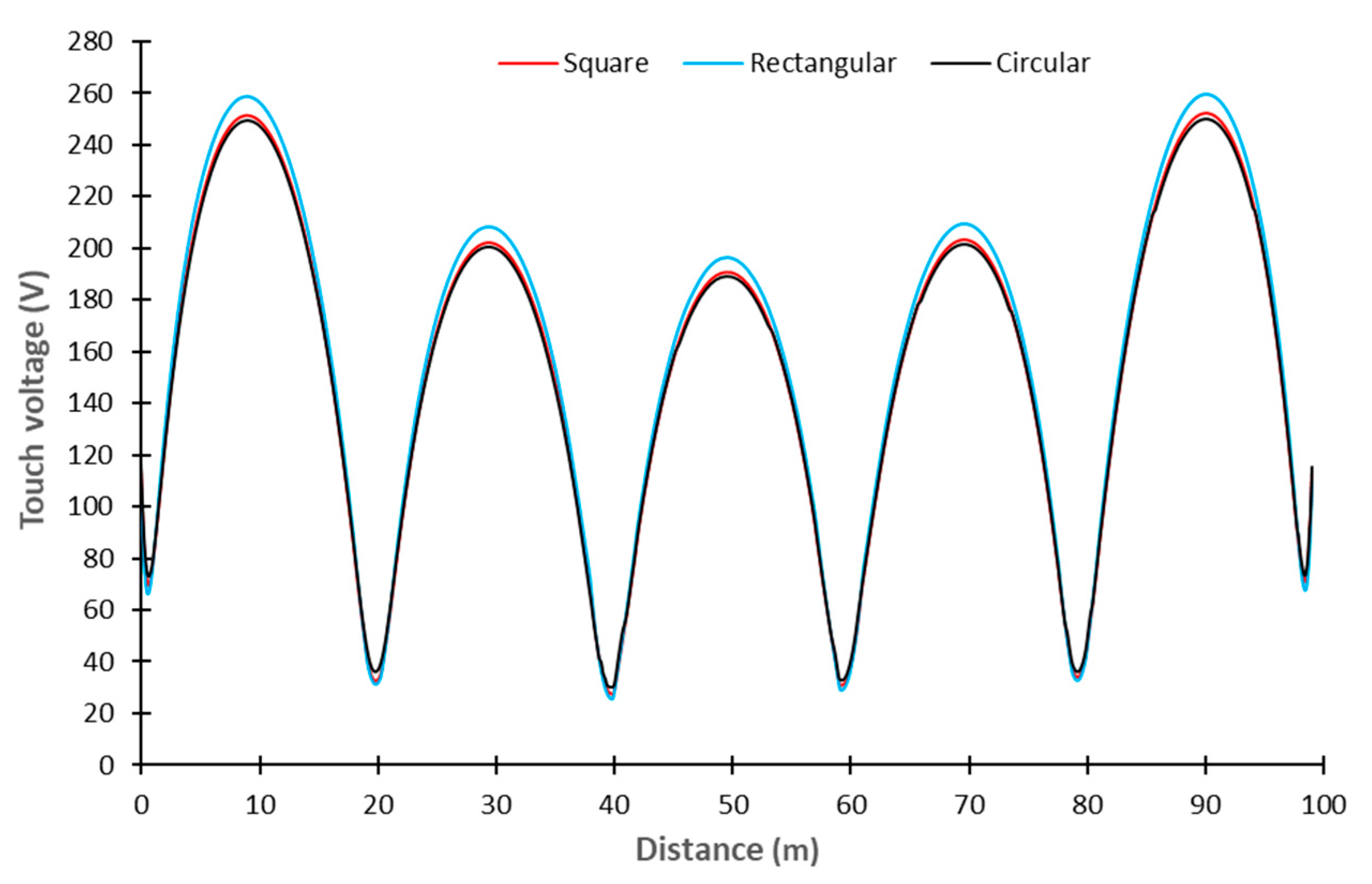
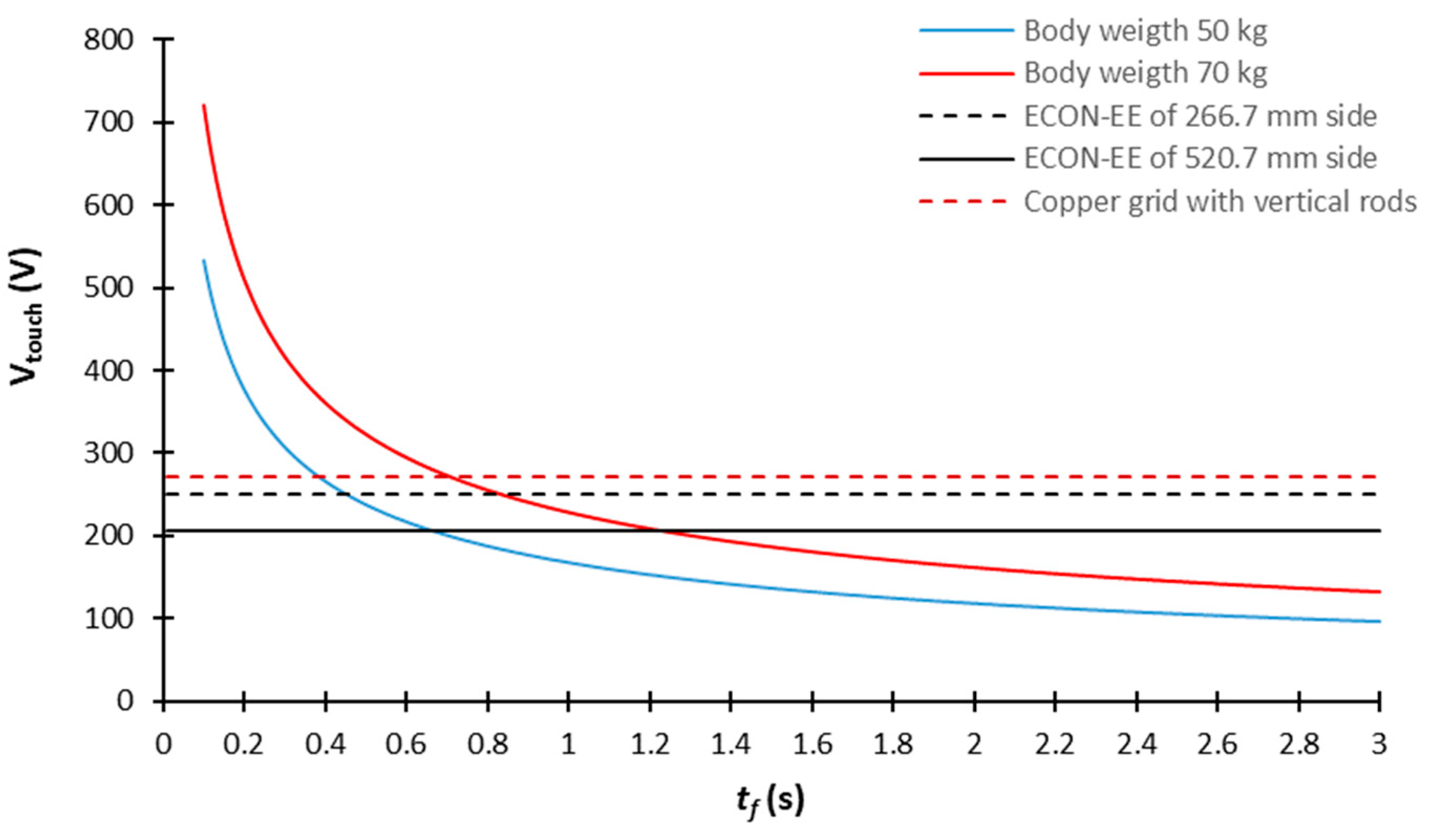
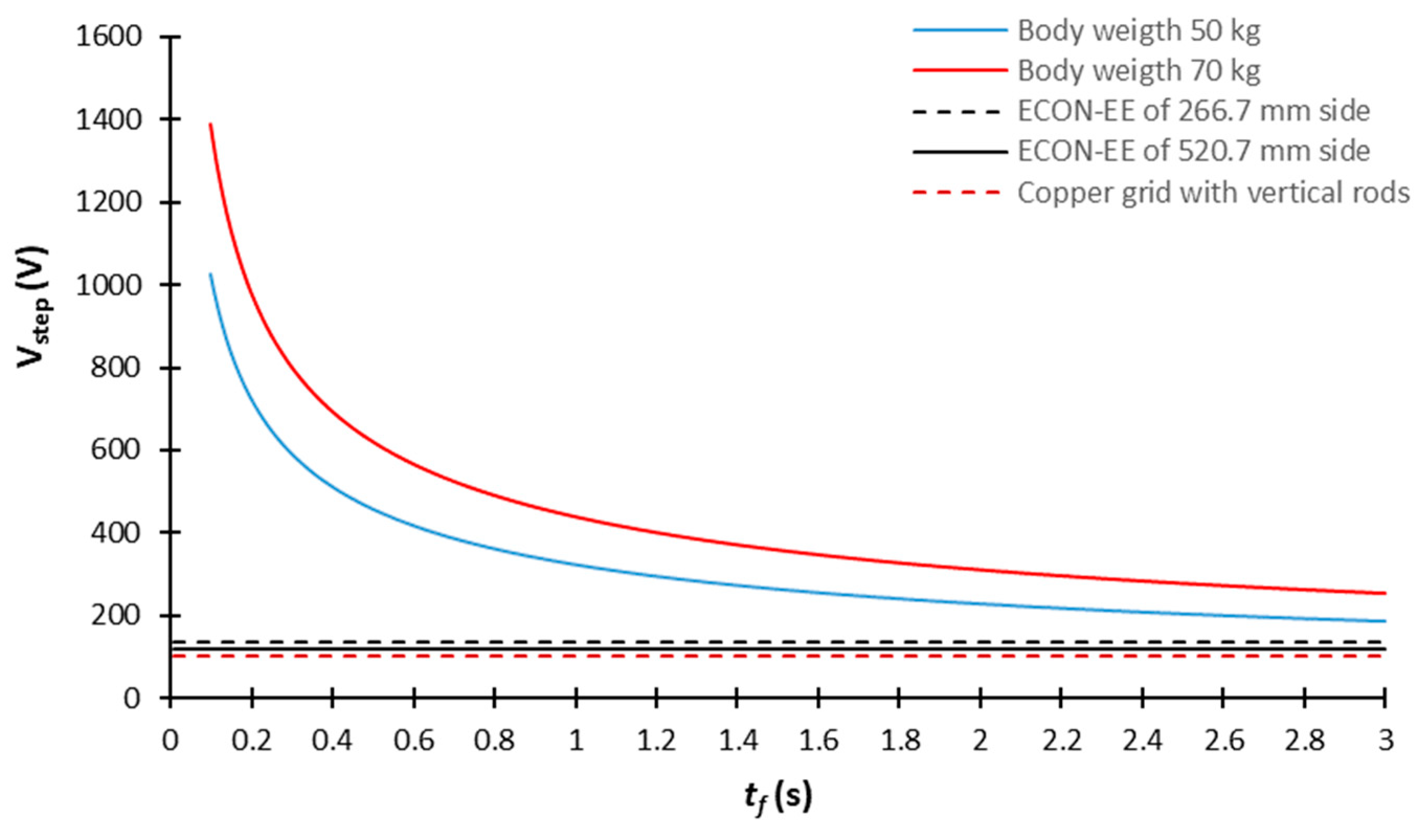
| k | RG (Ω) | Difference (%) |
|---|---|---|
| 1 | 1.284 | - |
| 2 | 1.108 | 22.47 |
| 3 | 1.054 | 6.09 |
| 4 | 1.021 | 3.40 |
| 5 | 1.001 | 2.09 |
| 6 | 0.999 | 0.20 |
| 7 | 0.998 | 0.10 |
| FEM | Grounding Software [28] | |
|---|---|---|
| RG (Ω) | 1.00 | 1–1.01 |
| GPR (V) | 745.54 | 743.9–749 |
| Vtouch (V) | 195.62 | 194.9–200.34 |
| Vstep (V) | 86.97 | 70.92–89.3 |
| FEM | Grounding Software [28] | |
|---|---|---|
| RG (Ω) | 0.980 | 0.97–0.974 |
| GPR (V) | 729.90 | 719.5–725.75 |
| Vtouch (V) | 271.09 | 261–268.81 |
| Vstep (V) | 100.52 | 101.3–117 |
| a (mm) | RG (Ω) | GPR (V) | Vtouch (V) | Vstep (V) |
|---|---|---|---|---|
| 114.3 | 1.059 | 789.01 | 295.38 | 142.20 |
| 139.7 | 1.047 | 779.73 | 285.33 | 141.68 |
| 165.1 | 1.036 | 771.34 | 276.76 | 140.91 |
| 190.5 | 1.026 | 764.08 | 269.08 | 139.42 |
| 215.9 | 1.017 | 757.33 | 262.12 | 138.41 |
| 241.3 | 1.009 | 751.23 | 255.94 | 137.26 |
| 266.7 | 1.001 | 745.55 | 249.83 | 135.86 |
| 292.1 | 0.994 | 740.28 | 244.42 | 134.60 |
| 317.5 | 0.987 | 735.31 | 239.03 | 133.11 |
| 342.9 | 0.981 | 730.70 | 234.46 | 131.64 |
| 368.3 | 0.975 | 726.35 | 229.85 | 130.12 |
| 419.1 | 0.964 | 718.09 | 221.49 | 127.01 |
| 520.7 | 0.945 | 703.70 | 206.97 | 117.51 |
| Copper Grid | Rebar Grid | |
|---|---|---|
| Conductor diameter (mm) | 9.27 | 12.7 |
| RG (Ω) | 1.188 | 1.176 |
| GPR (V) | 884.96 | 886.31 |
| Vtouch (V) | 394.88 | 386.22 |
| Vstep (V) | 117.16 | 118.71 |
| ρE (Ω-m) | ρ1/ρE | RG (Ω) | GPR (V) | Vtouch (V) | Vstep (V) |
|---|---|---|---|---|---|
| 300 | 1 | 1.176 | 886.31 | 386.22 | 118.71 |
| 150 | 2 | 1.090 | 811.80 | 319.07 | 125.21 |
| 50 | 6 | 1.030 | 766.93 | 272.4 | 131.75 |
| 10 | 30 | 1.004 | 748.02 | 252.11 | 135.38 |
| 5 | 60 | 1.001 | 745.62 | 249.83 | 135.86 |
| 1 | 300 | 0.998 | 743.61 | 247.40 | 136.37 |
| 0.25 | 1 200 | 0.998 | 743.61 | 247.40 | 136.37 |
| 0.01 | 30 000 | 0.998 | 743.61 | 247.40 | 136.37 |
| ECON Geometry | Section Area (m2) | Perimeter (m) | RG (Ω) | GPR (V) | Vtouch (V) | Vstep (V) |
|---|---|---|---|---|---|---|
| Square | 0.071 | 1.067 | 1.001 | 745.55 | 249.83 | 135.86 |
| Rectangular | 0.071 | 1.473 | 1.000 | 744.80 | 248.05 | 143.56 |
| Circular | 0.071 | 0.946 | 1.002 | 746.29 | 250.85 | 132.84 |
| ECON Geometry | Section Area (m2) | Perimeter (m) | RG (Ω) | GPR (V) | Vtouch (V) | Vstep (V) |
|---|---|---|---|---|---|---|
| Square | 0.071 | 1.067 | 1.001 | 745.55 | 249.83 | 135.86 |
| Rectangular | 0.048 | 1.067 | 1.011 | 752.99 | 257.18 | 145.59 |
| Circular | 0.091 | 1.067 | 0.993 | 739.59 | 243.92 | 130.57 |
| Rebar Diameter (mm) | Imperial Bar Size | RG (Ω) | GPR (V) | Vtouch (V) | Vstep (V) |
|---|---|---|---|---|---|
| 12.7 | #4 | 1.001 | 745.55 | 249.83 | 135.86 |
| 19.05 | #6 | 1.000 | 744.80 | 249.27 | 136.01 |
| 25.4 | #8 | 1.000 | 744.80 | 249.27 | 136.01 |
| 32.26 | #10 | 1.000 | 744.80 | 249.27 | 136.01 |
| 43.00 | #14 | 0.999 | 744.06 | 248.53 | 136.06 |
| 57.33 | #18 | 0.998 | 743.31 | 247.77 | 136.24 |
| Rebar Diameter (mm) | Imperial Bar Size | req (mm) |
|---|---|---|
| 12.7 | #4 | 142.74 |
| 19.05 | #6 | 143.70 |
| 25.4 | #8 | 144.40 |
| 32.26 | #10 | 144.97 |
| 43.00 | #14 | 145.67 |
| 57.33 | #18 | 146.37 |
Disclaimer/Publisher’s Note: The statements, opinions and data contained in all publications are solely those of the individual author(s) and contributor(s) and not of MDPI and/or the editor(s). MDPI and/or the editor(s) disclaim responsibility for any injury to people or property resulting from any ideas, methods, instructions or products referred to in the content. |
© 2023 by the authors. Licensee MDPI, Basel, Switzerland. This article is an open access article distributed under the terms and conditions of the Creative Commons Attribution (CC BY) license (https://creativecommons.org/licenses/by/4.0/).
Share and Cite
Daadaa, M.; Brettschneider, S.; Volat, C.; Simard, G. Numerical Investigation of the Use of Electrically Conductive Concrete-Encased Electrodes as Potential Replacement for Substation Grounding Systems. Energies 2023, 16, 4410. https://doi.org/10.3390/en16114410
Daadaa M, Brettschneider S, Volat C, Simard G. Numerical Investigation of the Use of Electrically Conductive Concrete-Encased Electrodes as Potential Replacement for Substation Grounding Systems. Energies. 2023; 16(11):4410. https://doi.org/10.3390/en16114410
Chicago/Turabian StyleDaadaa, Mouna, Stephan Brettschneider, Christophe Volat, and Guy Simard. 2023. "Numerical Investigation of the Use of Electrically Conductive Concrete-Encased Electrodes as Potential Replacement for Substation Grounding Systems" Energies 16, no. 11: 4410. https://doi.org/10.3390/en16114410
APA StyleDaadaa, M., Brettschneider, S., Volat, C., & Simard, G. (2023). Numerical Investigation of the Use of Electrically Conductive Concrete-Encased Electrodes as Potential Replacement for Substation Grounding Systems. Energies, 16(11), 4410. https://doi.org/10.3390/en16114410








